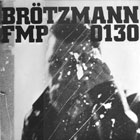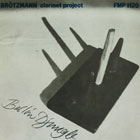Home » Jazz Articles » Multiple Reviews » Peter Br
Peter Br
 Peter Brötzmann
Peter Brötzmann
FMP130
Atavistic
2003
The trio of Brötzmann, Belgian pianist Fred Van Hove and Dutch percussionist and clarinetist Han Bennink came together in 1968 as the driving force behind Machine Gun (BRO/FMP) and Nipples (1969, Calig-Atavistic), both of which featured larger ensembles. With FMP 130 , other reedmen are jettisoned, as is a bassist, and the exploration and destruction of things like melody, rhythm, and form is more nakedly and strictly apparent than on previous releases. Though this is technically the second trio release ( Balls came two years earlier), the pieces here are shorter and more direct, having less of a tendency to meander - and as the adage goes, "brevity is the soul of wit."
"For-Donaueschingen-Ever," the opening slugfest, is very difficult to listen to without considering the visuals inherent in such a theatrical spar - Bennink punctuating Van Hove's Satie-esque runs as Peter's bass saxophone builds up rhythm, only to ultimately cause collision. The same almost happens two tracks later (ostensibly another take, entitled "Nr. 7"), until rising tenor and Bennink's madcap swing take off - and it ends as abruptly as it began. Bennink's theatrical crashing, yelling, and dhung-ing at first seems like it might be the show-stealer, but it is Van Hove's subtle, ambiguous humor and adeptness at various pianistic styles that really takes this music beyond neo-dada extremism.
 Peter Brötzmann Clarinet Project
Peter Brötzmann Clarinet Project
Berlin Djungle
Atavistic
2004
Recorded just over ten years later at the 1984 Jazzfest Berlin, Berlin Djungle has much more in common with the complex textures of recent projects like the Chicago Tentet. "What A Day" is a highly melodic work, yet still process-oriented. However, this process is additive, featuring juxtapositions of woody textures and shrill overblowing or lithe clarinet lines and dense masses of sound from bass and trombones. Alex von Schlippenbach and Bill Dixon come to mind as precursors for this sort of piece in terms of sound organization - compare parts of "What A Day" with the brass and wind writing on Intents and Purposes and Dixon's bespectacled influence becomes very apparent. With an ensemble culled from a potpourri of rising American and European underground stars, Louis Sclavis was the revelation here; his ebullient sense of "swing" and technical ability put him firmly in the annals of clarinetists and bass-clarinetists alongside Dolphy and Portal. But where there is lyricism in Sclavis and Tony Coe, Ernst-Ludwig Petrowsky, John Zorn and trombonist Johannes Bauer revel in the production of extraordinary sounds - and it wouldn't be Br'tzmann without madcap theatrics.
Just as Satie was a fly in the ointment in post-World War I Europe, so Peter Brötzmann and his compatriots in Germany and elsewhere in the '60s and '70s rose beyond gesture to process and change in improvised music. Thankfully, FMP and Atavistic have given us a snapshot and a window onto how the experience of history garners aesthetic response.
Tracks and Personnel
FMP 130
Tracks: For Donaueschingen Ever; Konzert F'r Zwei Klarinetten; Nr. 7; Wir Haben Uns Folgendes 'berlegt; Paukenh'ndschen im Blaubeerenwald; Nr. 9; Gere Bij; Nr. 4; Nr. 6; Donaueschingen For Ever.
Personnel: Peter Brötzmann: clarinet, saxophones; Fred Van Hove: piano, celeste; Han Bennink: drums, etc.
Berlin Djungle
Tracks: What A Day, First Part; What A Day, Second Part.
Personnel: Toshinori Kondo: trumpet; Johannes Bauer: trombone; Alan Tomlinson: trombone; Peter Brötzmann: clarinet, tenor sax, tarogato; Tony Coe: clarinet; J. D. Parran: clarinet; E. L. Petrowsky: clarinet; Louis Sclavis: clarinet, bass clarinet; John Zorn: clarinet, mouth pieces; William Parker: bass; Tony Oxley: drums.
< Previous
Steve Jenkins: Mad Science
Comments
Tags
For the Love of Jazz
 All About Jazz has been a pillar of jazz since 1995, championing it as an art form and, more importantly, supporting the musicians who create it. Our enduring commitment has made "AAJ" one of the most culturally important websites of its kind, read by hundreds of thousands of fans, musicians and industry figures every month.
All About Jazz has been a pillar of jazz since 1995, championing it as an art form and, more importantly, supporting the musicians who create it. Our enduring commitment has made "AAJ" one of the most culturally important websites of its kind, read by hundreds of thousands of fans, musicians and industry figures every month.


















